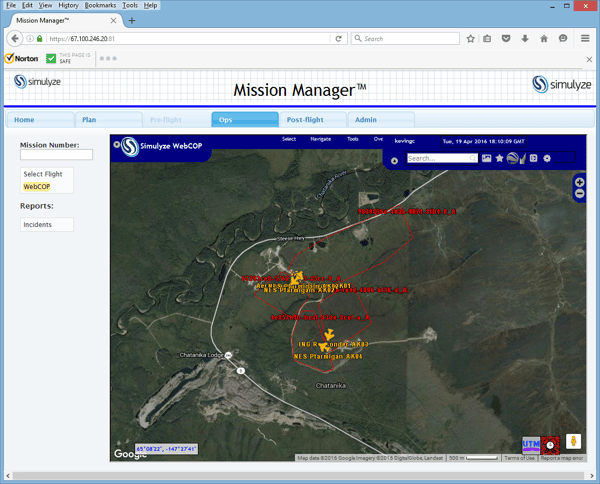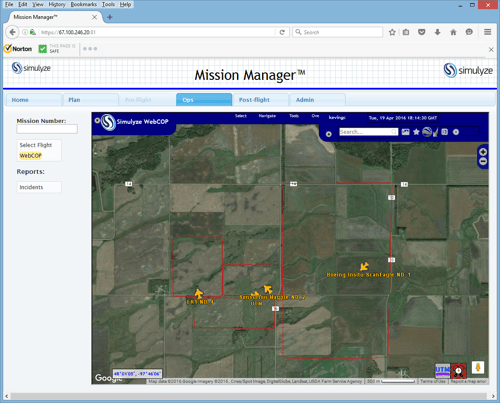
The commercial unmanned aircraft systems (UAS) industry has seen a rise in activity within the past year, with commercial drone registrations growing from around 500 in 2015 to more than 5,000 in 2016. While this spike is great for the industry, it’s highlighting the need for safe flight regulations to ensure that UASs and manned aircraft can coexist in shared airspace.
Recently, the National Aeronautics and Space Administration (NASA) has been putting drones to the test. NASA is continually working to develop forward-thinking solutions to today’s aeronautical challenges with UASs.
Just last month, NASA executed a test of its UAS traffic management (UTM) research platform, during which operators from six FAA UAS test sites across the country flew 24 drones in total, with 22 flying simultaneously at one point. The three-hour test of these drones was the first and largest demonstration of its kind that assessed the line-of-sight and rural operations.
The operators learned that using a traffic management framework to separate the aircraft and provide positional awareness to other operators helps promote the safety of integrating those two into the airspace.
During this test, operators outside of NASA also used the UTM research platform to enter flight plans and planned operations from several geographically diverse locations using various aircraft and software. The UTM research platform checked for conflicts, approved or rejected the flight plans and notified users of constraints. Weather could have proven to be a major challenge, but fortunately it cooperated at all sites, including Reno, Nev.; Rome, N.Y.; Corpus Christi, Texas; Blacksburg, Va.; and Bushwood, Md.
NASA provided simulated aircraft that were flown with physical UASs at each site, and the UTM research platform tracked all of the aircraft in the area, whether it was simulated or not.
To conduct a successful test, hours of coordination and logistics were required of the testers. Simulyze, in particular, provided support with our leading-edge operational intelligence (OI) technology and Mission Insight application at test sites in Fairbanks, Alaska, and Grand Forks, N.D. Mission Insight helped manage the mission operations for six aircraft during test flights on April 19.
The Mission Insight application, built on a proprietary OI platform, managed the entire data workflow for the UAS missions during these test flights. Mission Insight was able to submit flight plans, monitor aircraft status and telemetry, activate flights and transmit aircraft position data to the UTM research platform, all from a single web-based application.

Simulyze’s enterprise-level Mission Insight solution for UAS operators enabled pilots to consolidate on one system as opposed to working through several clients.
All of the aircraft telemetry was gathered from the individual ground stations and transmitted to the Mission Insight server. The server then transmitted all the aircraft position data to the UTM platform. Once NASA’s UTM tests were concluded, we were pleased we could announce a successful deployment of Mission Insight in support of NASA’s Technical Capability Level 1 testing of UAS.
Operational Intelligence’s Value in UAS Adoption
Mission Insight and OI have proven that they can be safely integrated into the National Airspace. OI provides the visibility and insight into data that will help ensure safety in the skies as more drones join the ranks. Ensuring the safety of unmanned operations requires the integration of vast amounts of disparate data. OI technology in UAS is vital to help pilots aggregate vast amounts of both structured and unstructured data in a central location to gain real-time access to critical information. Even in remote areas, OI can be used across a graphical interface for complete tactical situational awareness.
By adopting OI and Mission Insight, manned and unmanned flights are able to “talk to” one another via real-time data processing for drone pilots. OI can provide in-depth insight and intelligence from multiple sources and vast amounts of data. Mission Insight includes archival and replay capabilities that aids in post-operation analysis and review of operational effectiveness. It integrates various live event data such as weather conditions, systems information, GIS data, video and more. By consolidating all data into one application, mission managers and operators can easily achieve exceptional data insight and situational awareness that results in better, more strategic decisions and positive outcomes.
Simulyze is proud to have participated in NASA’s UAS traffic management research and to demonstrate the capabilities of OI and Mission Insight during strenuous test flights. Without visibility into what the other unmanned flights are doing around them, there’s a very real possibility for incidents between the drones and with other aircraft. Pairing Mission Insight with NASA’s technology can provide the pre-flight planning and post-flight analysis needed to support flight safety. The UTM tests demonstrated the technological advances that can be made when the expertise of NASA is combined with the capabilities of our nation’s UAS test sites.
We’re very excited to have participated in NASA’s UTM testing to demonstrate the capabilities of operational intelligence (OI) during unmanned flights and look forward to what the future holds.
To learn more about the role that OI can play in the UAS adoption, download our free eBook, “Operational Intelligence: Enabling the Future of Commercial Unmanned Operations.”
DroneBlog


